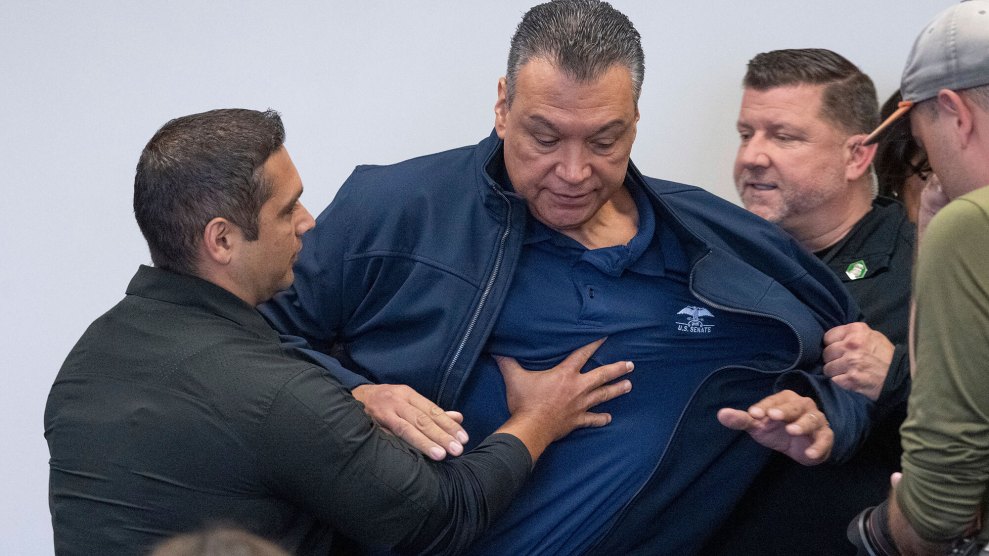The very idea of retiring in America had become a mirage–tantalizing, but always sliding into the distance. Those visions of golden years spent playing golf in Tucson or bridge in Boca Raton, promoted by AARP magazine and purveyors of retirement investments, are now nothing more than a chimera for most Americans. The exception, of course, is a wealthy minority, who for the past decade has been squirreling away money they should have been paying in taxes. For everyone else, old age been reduced to three alternatives: Those of us lucky enough to have jobs can keep working indefinitely; the rest can live poor or die.
Anyone who doubts this blunt truth should take a look at a few few recent trends. Start with something called the Retirement Income Deficit. Retirement USA, a consortium of non-profits and unions, which came up with the term, describes the deficit as follows:
Retirement USA asked the respected non-partisan Center for Retirement Research at Boston College to calculate the figure that represents our current retirement income deficit – that is, the gap between the pensions and retirement savings that American households have today and what they should have today to maintain their standard of living. Using the data from the Federal Reserve Board’s Survey of Consumer Finances, the Retirement Research Center has calculated that figure at $6.6 trillion.The deficit figure covers households in their peak earning and saving years—those in the 32-64 age range—excluding younger workers who are just beginning to save for retirement as well as most retirees. It takes into account all major sources of retirement income and assets: Social Security, traditional pension plans, 401(k)-style plans, and other forms of saving, and housing.
The measure assumes people will continue to work, save, and accumulate additional pension and Social Security benefits until they retire at age 65, later than most people currently retire. It also assumes that retirees will spend down all their wealth in retirement, including home equity. The deficit is thus in many respects a conservative number.
This gap is due, in large part, to the demise of the old-fashioned, fixed-income pension system. According to the Pension Rights Center, total employment in the nation today stands at 130 million, of which 108 million people are employed by private business and 22 million public. The traditional fixed-benefit plans now cover only about 20 percent of the private workforce, and 79 percent of public workers. Half the entire private workforce today has no retirement system at all. And those with 401ks are at the mercy of the mutual fund companies, with their futures staked on the stock market. In the recession, those plans took a dive, losing one quarter to one third their assets.
Even public employees lack the retirement security they once had. There are recent reports that states, because of their own budget deficits, can’t pay retirement monies to their pubic services workers. The news is hyped by politicians and way overstated, said Keith Brainard of the Public Fund Survey, an outfit sponsored by the National Association of State Retirement Administrators and the National Council on Teacher Retirement. Still, pension plans that cover public service workers and teachers in New Jersey, Illinois, and the city of Philadelphia may be at risk, according to Brainard. About 70 percent of state employees are covered by Social Security, but a good 30 percent would be left out in the cold if the plans went down.
But that’s not the end of it. The big financial institutions that run the 401k plans have been busy applauding the comeback of the stock market, suggesting that it redeems the whole 401k concept. Unfortunately, as the recession wears on, a whole lot of people are withdrawing money from their 401ks, instead of (or in addition to) contributing to them. Fidelity Investments included the following in a recent report on developments in the second quarter of 2010:
While the majority of 401(k) participants continued to save during the quarter, the percentage of participants either initiating a loan or a hardship withdrawal increased. Loans initiated over the past 12 months grew to 11% of total active participants from about 9% one year prior. The portion of participants with loans outstanding also increased two full percentage points in the second quarter to 22%. The average initial loan amount as of the end of the second quarter was $8,650 with an average loan duration of three and half years….
During the second quarter of this year, 62,000 participants initiated a hardship withdrawal, as compared to 45,000 participants who initiated one during the prior quarter. As of the second quarter, 2.2% of Fidelity’s active participants took a hardship withdrawal, up from 2.0% one year prior. Additionally, 45% of participants who took hardship withdrawals one year prior also took a hardship withdrawal in the 12 month period ending in the second quarter of this year. Plan sponsors report that the top reasons why participants are taking hardship withdrawals are to prevent foreclosure or eviction, pay for college, and the purchase of a primary residence.
Fidelity has found that the average age of those taking a loan or hardship withdrawal is between 35 and 55 years old – a worker’s peak earning years – when individuals often have to deal with multiple, competing, financial challenges. Distributions from a 401(k) or 403(b) are taxed as ordinary income, plus if you are under age 59½ you may be subject to a 10% early withdrawal penalty.
I don’t know much about the pitfalls of 401k loans, so I called up Rebecca Davis, Legislative Counsel at the Pension Rights Center. She explained that if you have a 401K worth $100,000, you can borrow up to half that amount. Before getting the money you need to work out a repayment plan that includes an interest payment to yourself. And that’s where the hitches begin.
To start with, the 401k plan may well charge you a fee for all this; that fee varies from plan to plan. Moreover, when you take the loan from your own plan you must immediately pay the government a flat 10 percent tax—because the money you have withdrawn becomes taxable income. Finally, if you quit your job or get laid off, the loan to yourself from your own plan becomes due immediately–just at the moment when you probably won’t be able to pay it back. And if you don’t pay it back, you’re subject to early withdrawal penalties.
Then comes this important bit of information: The money in your 401k is normally protected from creditors. If you go bankrupt, for example, the creditors can’t get at the money. But once the money is removed from the protective cover of a 401k, pension, or IRA, then it can be seized. So now you’re broke and jobless, and you have to use your retirement funds to pay your debts. In other words, you are screwed from every possible direction. And if you think things are bad now, just wait until you get old.
Did I mention that Republicans and Democrats alike now want to cut Social Security? Probably not for today’s geezers, but for the old folks of the future–in other words, for precisely the same people who stand to have disappearing pensions and depleted 401ks.
















